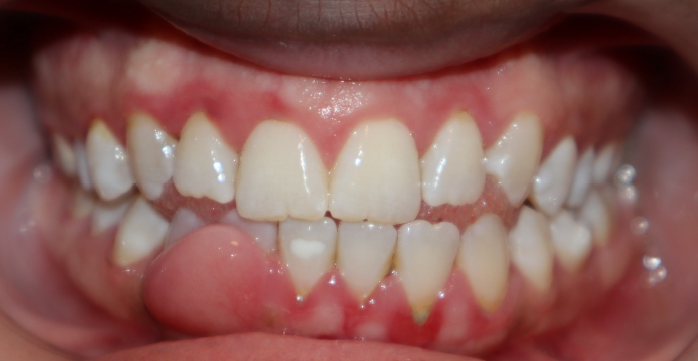Gingival Abscess Treatment in 2025: Symptoms, ICD-10 Code, Drainage & More
If you’re experiencing swelling, tenderness, or a painful bump on your gums, you might be dealing with a gingival abscess. This common dental emergency is easily treatable—but only if caught early. At Tribute Family Dentistry, we’re seeing more people in 2025 searching for terms like gingival abscess treatment, gingival abscess pictures, and causes of gingival abscess. Here’s everything you need to know.
What Is a Gingival Abscess?
A gingival abscess is a pocket of pus that forms within the gum tissue, often at or near the margin of the gumline, and is typically caused by bacteria. This condition is most often associated with food particles or foreign objects trapped in the gum.
It differs from other types of dental infections, including periodontal abscesses, which involve deeper gum pockets and underlying bone structures.
Gingival Abscess vs. Periodontal Abscess
| Feature | Gingival Abscess | Periodontal Abscess |
|---|---|---|
| Location | Gum margin near a tooth | Deep inside a periodontal pocket |
| Cause | Foreign body or food impaction | Chronic periodontitis (advanced gum disease) |
| Tooth mobility | Usually none | Often present |
| Treatment | Drainage, local cleaning | Scaling, root planing, drainage, antibiotics |
| Progression | Acute onset, superficial | Chronic or acute; deeper infection, possible bone loss |
If you’re unsure what type of abscess you’re experiencing, visit our periodontal treatment page or call our office for an evaluation.
What Does a Gingival Abscess Look Like?
Patients often describe it as a red or white bump on the gum near a tooth. It may be tender, swollen, and warm to the touch. Some people notice pus, bleeding, or discomfort when brushing or eating. You may also have a bad taste in your mouth if the abscess starts to drain.
If you’re searching for gingival abscess pictures, we recommend viewing medically reviewed sources or visiting us for a safe and accurate diagnosis—we do not recommend relying on Google Images alone.
What Causes a Gingival Abscess?
The most common causes include:
- Trapped food particles (e.g., popcorn husk, meat fibers)
- Aggressive brushing or dental trauma
- Poor oral hygiene
- Untreated gingivitis
- Orthodontic appliances irritating the gum
- Foreign bodies (toothpicks, floss, etc.)
Over time, bacteria build up and cause a localized infection, which results in an abscess. The infection can spread if left untreated.
Gingival Abscess ICD-10 Code
If you’re tracking your dental condition for insurance or medical records, the ICD-10 code for a gingival abscess is:
K05.22 – Acute gingival abscess
This code may be used for claims, referrals, or hospital visits.
Treatment of Gingival Abscess in 2025
At Tribute Family Dentistry, we take a modern and gentle approach to treating gum abscesses. Here’s how we handle it:
✅ 1. Diagnosis & Imaging
We examine the area and use X-rays to rule out deeper infections, such as periapical or periodontal abscesses.
✅ 2. Drainage
If pus is present, we gently drain the abscess under sterile conditions. This often provides immediate relief.
✅ 3. Debridement & Cleaning
The area is cleaned to remove bacteria, food particles, and any foreign objects.
✅ 4. Antibiotics
In more advanced cases, or if infection is spreading, we prescribe antibiotics to support healing.
✅ 5. Follow-Up & Prevention
We’ll show you how to avoid future issues through proper hygiene and offer preventive care like professional cleanings.
Differential Diagnosis: What Else Could It Be?
| Condition | Location | Symptoms | Pus Present? | Key Differences |
|---|---|---|---|---|
| Gingival Abscess | Gum margin near the tooth | Red, swollen bump, tenderness, localized pain | ✅ Yes | Superficial gum infection, often from trapped food or trauma. |
| Periodontal Abscess | Deeper gum pockets | Deep pain, bad taste, tooth mobility, bleeding | ✅ Yes | Linked to gum disease and deeper bone involvement. |
| Periapical Abscess | Tooth root tip | Severe toothache, pressure, possible swelling | ✅ Yes | Originates from decay or trauma inside the tooth. |
| Gingivitis | Gum line | Redness, swelling, bleeding while brushing | ❌ No | Inflammation without pus. No bump or acute pain. |
| Canker Sore | Inside lips/cheeks | Small, painful ulcer with red border | ❌ No | Not infected. Self-limiting. |
| Irritation Fibroma | Inner cheek, gums | Firm, painless bump | ❌ No | Benign growth from trauma like cheek biting. |
| Dental Sepsis | Whole body (from dental origin) | Fever, chills, confusion, swelling | ✅ Yes (source) | Systemic infection. Medical emergency. |
Gingival Abscess FAQs
How do you treat a gingival abscess?
Drainage and debridement are key, often followed by antibiotics.
What does a gingival abscess look like?
A swollen, red or white bump on the gum—often painful and pus-filled.
What is the difference between a gingival abscess and a dental abscess?
A gingival abscess is in the soft gum tissue. A dental (periapical) abscess starts in the tooth root.
How serious is an abscess on the gum?
Very serious if untreated. It can spread to the jaw or bloodstream.
Will a gum abscess eventually burst?
It may, but that doesn’t mean it’s healed. You still need treatment.
Can a gum abscess heal with just antibiotics?
Rarely. Drainage and local cleaning are typically required.
What draws out a gum abscess?
Dentists use sterile tools to drain it. Home methods are not effective.
What does dental sepsis feel like?
Fever, fatigue, chills, and confusion. It’s a medical emergency.
What happens if an abscess bursts in your mouth and you swallow it?
It’s usually not harmful, but the infection remains. See your dentist.
What is the strongest natural antibiotic for tooth infection?
Garlic and clove oil may reduce symptoms—but are not replacements for dental treatment.
What can be mistaken for a tooth abscess?
Gingivitis, canker sores, or cysts may appear similar but require different care.
What is the difference between a periodontal abscess and a periapical abscess?
Periodontal affects gums; periapical stems from deep inside the tooth.
How long can an abscessed tooth last untreated?
Days to weeks—but infection will worsen and may become life-threatening.
What should I do if a dental abscess bursts on its own?
Rinse with salt water, avoid touching it, and see your dentist ASAP.
Get Expert Help in Frisco, TX
If you’re dealing with a possible gum infection, don’t wait for it to get worse. Contact Tribute Family Dentistry today and we’ll get you seen—often the same day.
For patients looking for gentle, judgment-free care, learn about our team and philosophy.



